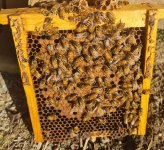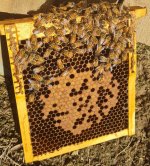I know most people probably including myself would say you would be mad to try and breed queens now. So just recording this for interest.
I had some queenless nucs I was going to write off for the winter, but late last month noticed one of my best hives still had a lot of drones. So I took a punt and did a graft, aiming to get 21 queens. The drones were still around come mating time and I was able to get enough semen to inseminate 7 of the queens on Sunday the 5th of this month (May). The nucs had been queenless a while and very weak so I direct introduced 4 of the queens as I thought eating out candy might not happen. Turned out to be a mistake, all 4 were tossed out dead the next day. But the other 3 were introduced by cage and have been accepted and now laying.
The rest of the queens were still virgins so since I had the nucs I introduced them just on the off chance they might find a drone or two, again on Sunday the 5th. Haven't looked at them all but I took a look in a few before I got chased off by a downpour of rain, all the nucs were queenless bar one, which had a nice looking queen just laying her first eggs. Still got to wait to see if they develop into workers I guess but looking promising. I will update in a week or so .
.
I had some queenless nucs I was going to write off for the winter, but late last month noticed one of my best hives still had a lot of drones. So I took a punt and did a graft, aiming to get 21 queens. The drones were still around come mating time and I was able to get enough semen to inseminate 7 of the queens on Sunday the 5th of this month (May). The nucs had been queenless a while and very weak so I direct introduced 4 of the queens as I thought eating out candy might not happen. Turned out to be a mistake, all 4 were tossed out dead the next day. But the other 3 were introduced by cage and have been accepted and now laying.
The rest of the queens were still virgins so since I had the nucs I introduced them just on the off chance they might find a drone or two, again on Sunday the 5th. Haven't looked at them all but I took a look in a few before I got chased off by a downpour of rain, all the nucs were queenless bar one, which had a nice looking queen just laying her first eggs. Still got to wait to see if they develop into workers I guess but looking promising. I will update in a week or so





